How to Streamline Campaign Management with Google’s Automated Ad Rules
by Ana Gotter • May 23, 2019
Managing a Google Ad account can be exhausting, mostly because it’s exceptionally time-consuming. It can take a lot of time, effort, and strategy to actually create all of the campaigns, and then you need to actively manage them.
You need to watch for drops in conversions and skyrocketing bid costs to see if campaigns need pausing, revamping, or stopping, and it’s also important to watch for things like high profitability so you can funnel more ad spend there. Then you need to watch for irrelevant keywords, audiences coming your way you didn’t expect, and any signs of trouble in paradise (high clicks but no conversions, for example, a signal that something needs to be switched up).
Enter Google’s automated ad rules, which can significantly speed up the management process. Within this post, we’re going to discuss exactly how to use them to streamline the management of your ad campaigns while optimizing them for better results on an automatic basis.
What are Google’s Automated Ad Rules?
If you’re familiar with the IFTTT software, Google’s automated ad rules work on a similar basis, helping you to semi-automate your campaigns so that if one specific event happens, a specific action will be taken.
You could decide, for example, to set a rule that will increase your budget for high-profit campaigns. In the example here, we’ve got a rule to increase the budget by 25% (up to a $500 limit) if any campaigns have a cost under $0.45 and a conversion rate higher than 10%. The budget increase will happen daily, and in this case you’ll get an email only if there’s an issue.
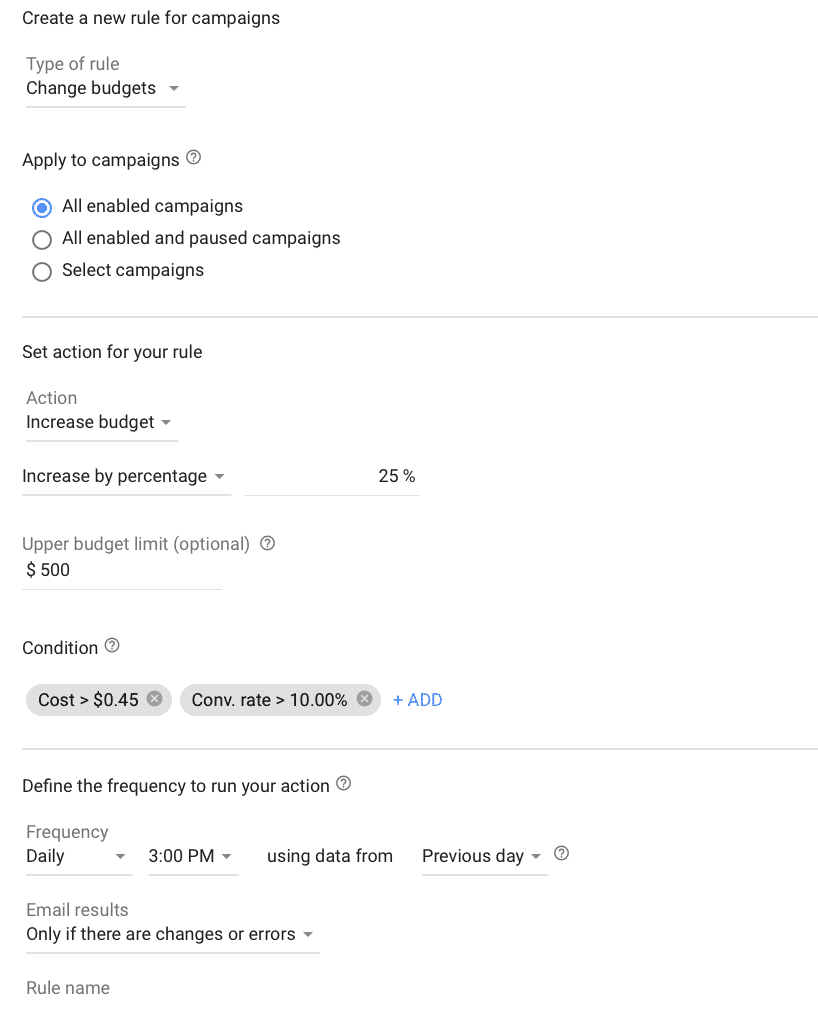
These rules can be a game changer for big accounts running a lot of campaigns and struggling to keep up. While automated rules will never be the same as a manual evaluation, they can take care of tasks that you know you’d take without question so that you don’t have to.
It’s also entirely up to you if you want to be notified or not of account changes made with automated rules. If you do choose to be notified, you’ll get an email at the intervals requested or when changes occur.
What are My Options?
There are an enormous number of ad rules that you can create, and plenty of different conditions that you can choose from. When you pull up the “Rules” section to create a new one, you’ll be hit with a long list of different options.
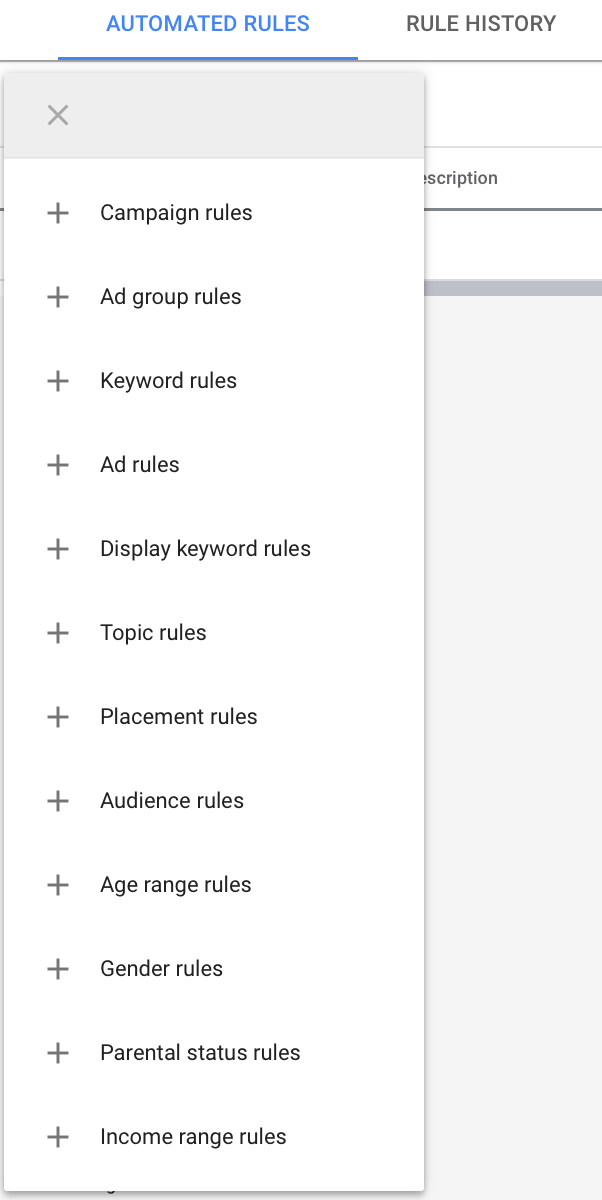
This can be really overwhelming, but the customization potential here is massive: you can create rules for most scenarios that you can think of, which can take part immediately or on an automated basis.
Types of automated rules you can create include:
- Campaign rules, which allow you to change campaigns based on factors like performance, cost, keyword, and more.
- Ad group rules, which allow you to impact actions on ad groups meeting the rule’s requirements, including changing a bid pause ad groups, or notify you of an action.
- Keyword rules, which allow you to pause, enable, or change up bids for keywords based on different factors.
- Ad rules, which allow you to pause or enable ads based on certain factors.
- Display keyword rules, which allow you to impact change on your Google display campaigns
- Topic rules, which allow you to pause or enable campaigns, or change bids or max CPCs based on certain topics.
- Placement rules, which allow you to make changes on ads of certain placements.
- Audience rules, which use the filter of audiences in order to determine if automated rules should be applied.
- Age range rules, which take the age range of your followers and clicks into account when deciding to apply automated rules.
- Gender rules, which allow you to make changes based on the gender of your ads’ viewers.
- Parental status rules, which allows you to adjust campaign aspects like bid or max CPC on certain parental statuses based on several factors.
- Income range rules, which, as you guessed it, allows you to alter campaign assets when showing the ad to users who fall within certain income ranges.
There are a lot of options here, each one lets you take different actions (often enable, pause, or change bids) based on different conditions that you can choose and specify. There’s a lot of control involved; you’re not going to be left stuck between two choices when neither is quite right for you.
How to Set Up Automated Ad Rules
Setting up automated ad rules is a quick and easy process. Start by heading to your Google Ads dashboard, and then clicking the Tools bar in the top right-hand corner. Once you do this, find “Rules” in the drop-down menu that pops up.

Next, click to “Rules,” and then click on the blue plus sign to create a new one.

A large drop-down menu will appear, letting you choose what type of rule you want to create. Consider what actions you want taken and on which campaigns; this will help you choose where to start. For this example, we’ll look at implementing keyword rules.
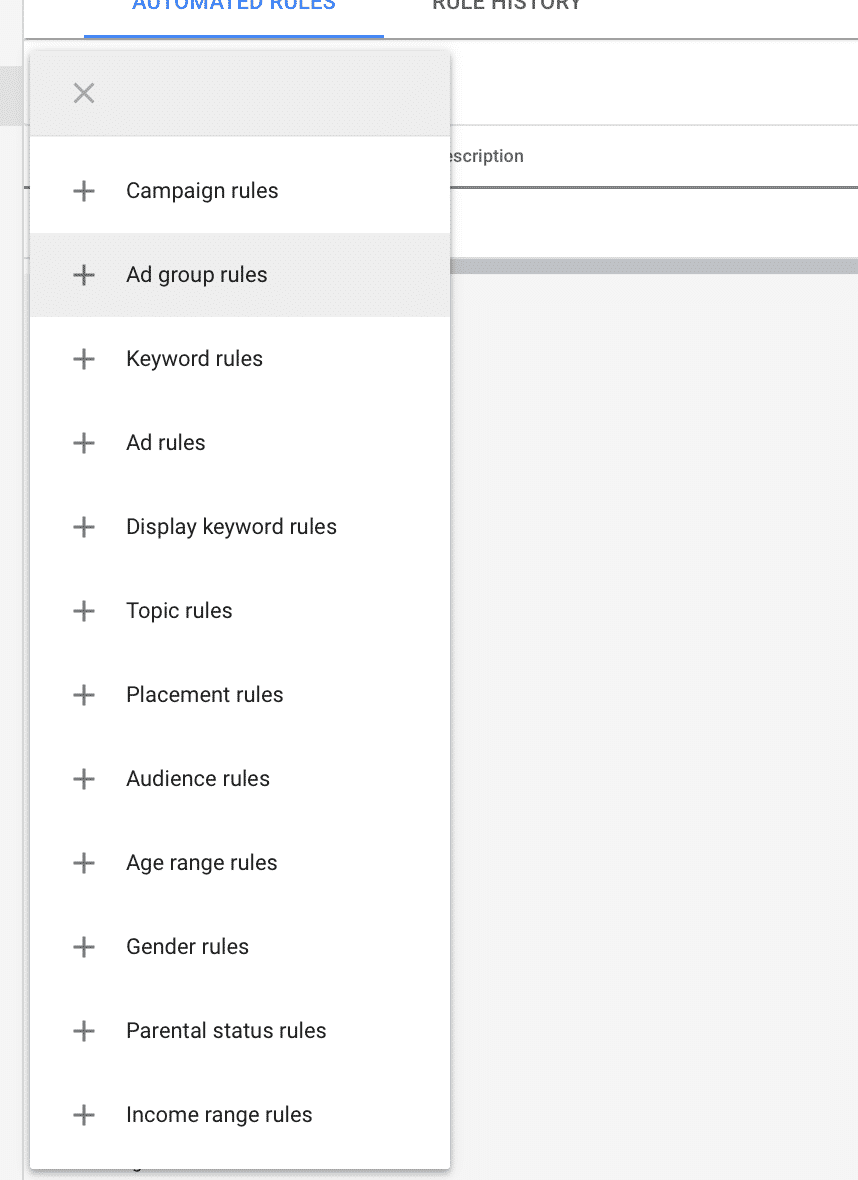
First, choose what general action you’d like taken. Options will typically include some variation of “pause,” “enable,” change bids,” “change budget,” and “send email.”
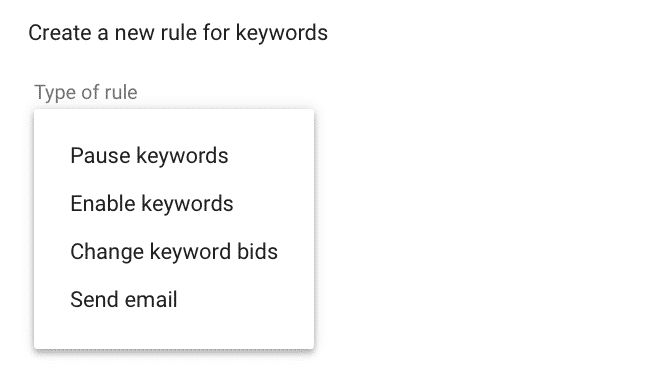
Now, you’ll decide which campaigns or keywords you want to apply it too. You can apply it to all keywords that are enabled, all those that are paused, those that are in selected campaigns, and those only in select groups. Decide which you want to choose, and ideally keep it as narrow as possible unless you want an across-the-board change.
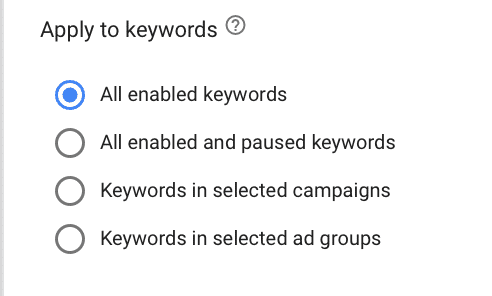
The next step will involve choosing a specific action for the general change you’re going for. In this example, you can choose from options like “set new bids,” “increase bids,” and “raise bids to top of page CPC.” Pick the one that’s relevant to what you want to implement.
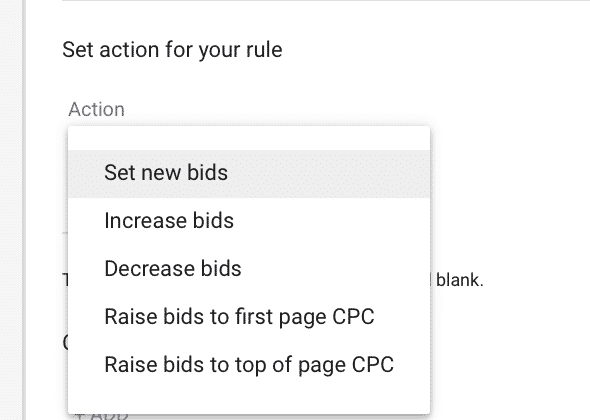
Now it’s time to get really specific. In this example, we’re increasing the bids by 25% (though we could also choose an exact dollar amount) putting a bid limit of up to $500. I’m not entirely sure what you’d be bidding on for $500, but more power to you!
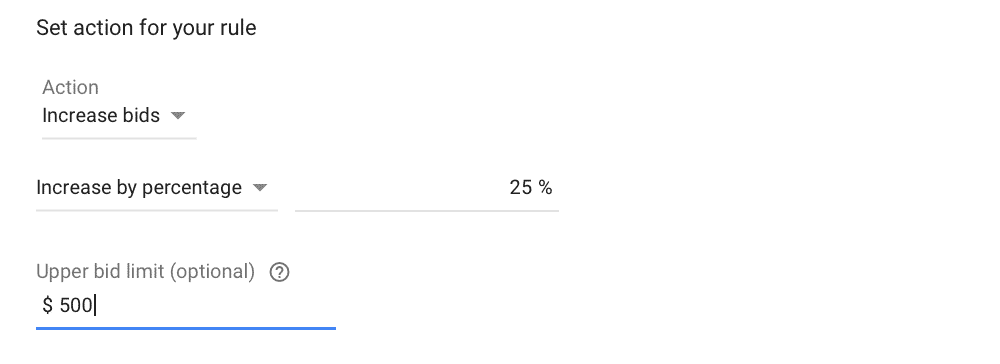
Next, set the conditions for the rule. This will tell Google exactly when to implement the actions that you want taken, and you can go for broader conditions like “quality score about 8″ or get specific by adding multiple conditions like “CPC is less than $0.45” and “conversion value is greater than $90.”
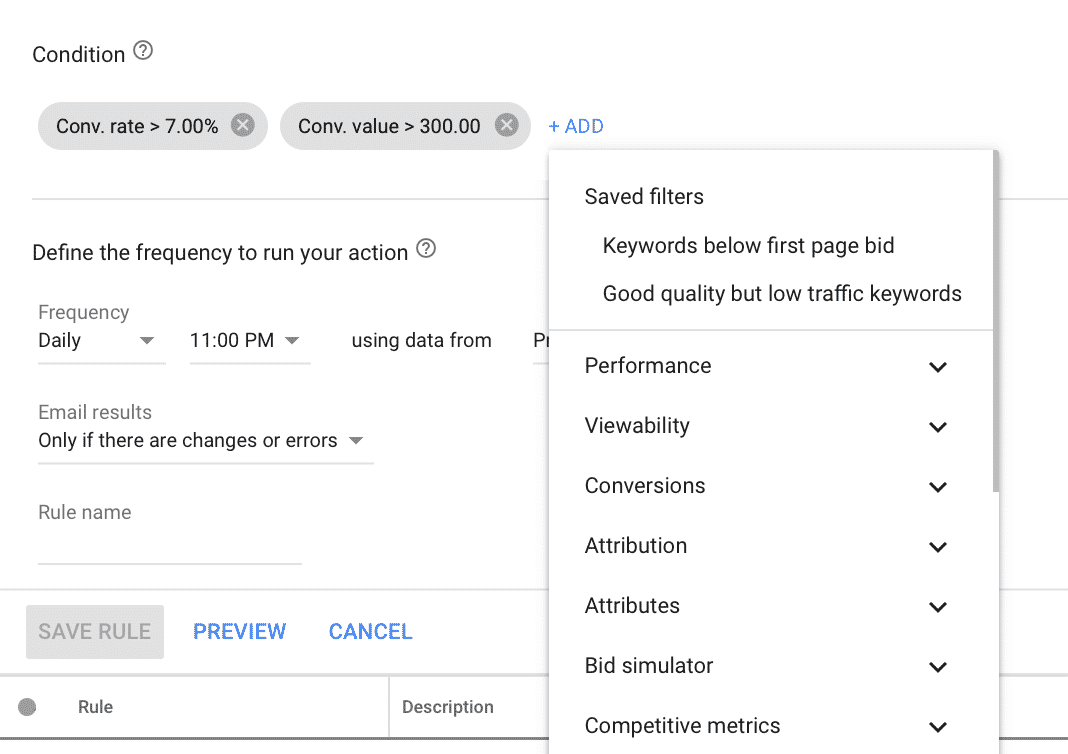
Finally, you’ll decide how often you want this rule to be applied to your campaigns. By choosing to have a daily frequency at 11 pm in this example, you could see your bids jumping on relevant campaigns day after day. Because of this, it’s typically good to shift rules like this to take place weekly or even monthly instead of daily, but you can have simple enable/pause campaigns set to check for status daily.

Finally, decide when you want to be notified about the effects of a rule. You can be notified every time something changes, but if we’re talking a ton of campaigns and you’re already manually reviewing them, this could bog you down. Sometimes, if the rule has been tested before and you’re confident in it, it can be a good call to get emails only if there are changes or errors, but this is up to you. If regular emails help you stay on top of everything, full steam ahead for more emails!
4 Automated Ad Rule Use Cases
Automated rules clearly have an enormous number of use cases, and you can customize them to fit your needs and the campaigns that you’re running.
If you aren’t entirely sure where to get started, the following use cases are relatively safe bets:
- Pausing campaigns or lowering their budgets if the cost is high or the conversion rate is too low.
- Increasing bids and/or budgets on specific keywords or campaigns based on conversion rates, CTRs, and cost-per-click. This will help you to automatically put more of your ad spend into the campaigns that are working.
- Automatically pausing or enabling campaigns around specific events, like a holiday or a key promotion that you’re featuring on search or display ads, so you don’t have to do it manually.
- Increasing bids on keywords yielding high conversion rates, and thus indicating that they’re high-value.
While you should add as many conditionals as you need to make sure that your automated rules are working for you, remember that they’re pretty simple “if this, then that” statements that can be used to enhance your campaigns as needed.
3 Best Practices for Automated Ad Rules
When you’re creating automated ad rules, it can be difficult to know where to start or
- Don’t mistake semi-autopilot for true autopilot. Rules should never be left unsupervised for long. If you choose not to be noticed of changes made through email alerts, you should be checking in on a regular basis to ensure that these rules are working in your favor. You may find that you need to alter a rule to make it more specific or more broad, or to stop one altogether. The rules are only simple coding to put changes in place, they can’t actually tell you if it’s the right choice. Only manual review can help you assess this.
- Start with manual and then move to automated. PPC campaigns can be a little bit like making a great marinara sauce. There’s no ironclad recipe, and you need to adjust the seasonings and ingredients as it cooks. Because you need to test ad changes on everything from increased bids to increased budgets to ensure that any new additions will help your campaigns, you should only create automated rules after you’ve manually tested them on at least one campaign and seen its effects.
- Consider the rule’s impact. You decide to pause all the campaign’s you’re running for certain keywords because you noticed that one campaign had a glitch. Cool! Are you going to restart them at some point? If so, you’ll have to go back and manually restart the ones you want, and this means sorting through it all. Another scenario: you have rules in place so that any campaigns with a low CPC increase your budget to a certain point. If you do this with all your campaigns, though, you can end up chewing up a lot of budget quickly and somewhat indiscriminately. Even with low CPCs hanging out below a certain point, not all campaigns are created equal; some will have higher conversation rates than others, or sell products that have a higher profit margin.
Think about the full impact that an automated rule will have and what comes once it’s been put in place across the board. This can help you narrow down rules, add in necessary conditions you may not have thought of, and determine what should be automated and what shouldn’t.
Conclusion
Google’s automated ad rules are a huge asset to busy advertisers who want to simplify their day-to-day tasks just a bit.
That being said, automated rules are no true replacement for actual manual reviews. I use them like a fail-safe, ensuring that I’m investing more into profitable campaigns and that I’m pulling from those that aren’t doing so well. They’re useful, but when it comes to PPC advertising, the devil is often in the details, and it’s impossible to create an ad rule for every single scenario out there. Consistent campaign oversight will always be important.
Need help optimizing and managing your Google Ad campaigns? Get in touch with us to learn more about how we can help you!
What do you think? Do you use automated ad rules on your PPC campaigns? Which rules do you implement to streamlines your campaign management? Share your thoughts and questions in the comments below!




